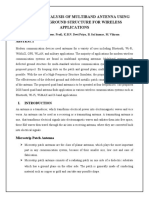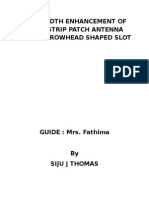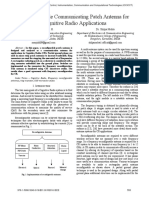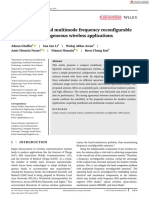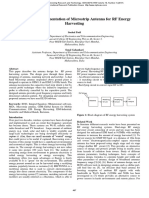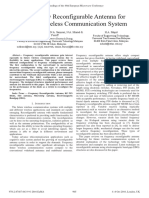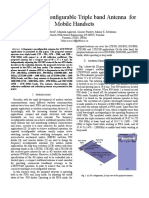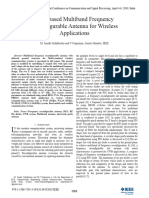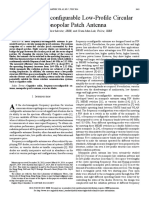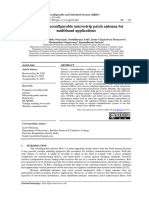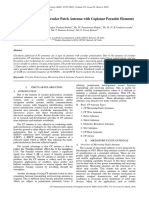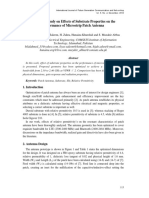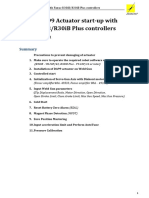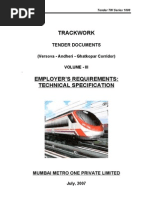Resumo Boom
Resumo Boom
Uploaded by
Aml LimaCopyright:
Available Formats
Resumo Boom
Resumo Boom
Uploaded by
Aml LimaCopyright
Available Formats
Share this document
Did you find this document useful?
Is this content inappropriate?
Copyright:
Available Formats
Resumo Boom
Resumo Boom
Uploaded by
Aml LimaCopyright:
Available Formats
© 2017 IJEDR | Volume 5, Issue 3 | ISSN: 2321-9939
Survey on Different types of reconfigurable Patch
Antenna for Wireless Applications
1
K. Mahendran, 2G. Manikannan
1,2
Assistant Professor, CK College of Engineering and Technology, Cuddalore, Tamil Nadu
Abstract — With the rapid advancement in wireless communication, reconfigurable antenna is gaining greater attention.
Reconfigurable antenna have more advantages when compared with the conventional antenna. Reconfigurable antenna
provide diversity feature of frequency, polarization and radiation pattern which is used in various applications. To achieve
high bandwidth and high gain in wireless applications, reconfigurable Microstrip patch antennas are used. Different
reconfigurable Microstrip patch antennas are analyzed and summarized in this paper.
Keywords — Microstrip patch antenna, Reconfigurable antenna
I. INTRODUCTION
Microstrip patch antennas are printed directly onto a circuit board it becoming more useful. It is more popular due to its compact
size, low cost, light weight, etc. It has an inherent characteristics such as light weight, low Profile, low cost, mechanically robust,
compatibility with Integrated circuits and very versatile in terms of resonance Frequency. . Microstrip antenna has high bandwidth
and gain.[5]. In high performance aircraft, spacecraft, satellite, and missile applications, microstrip antennas are widely used.
Presently there are many other government and commercial applications such as mobile, radio and wireless communications
where microstrip patch antennas are being given preference.
A. Reconfigurable antenna
Reconfigurable antenna is an antenna which is capable of reconfiguring its characteristics such as frequency, radiation pattern and
polarization to adapt the environment. In recent years the reconfigurable antennas are attaining great attention especially in
wireless communication systems due to its ability to reduce front end system and also allow pre-filtering at the receiver side. The
reconfigurable antennas also contain many other features like low cost, multipurpose functions, and size miniaturization.
Microstrip antenna has been used as a platform to design reconfigurable antenna. The requirement of increase bandwidth, gain
performance can be achieved by reconfigurable antenna. The basic working principle of this reconfigurable antenna is achieved
by switching the status of an RF switch (ON or OFF mode) affects the current distribution of the antenna. Switching components
such as PIN diodes, varactor diodes, MEMs switches, and optoelectronic switches are normally used to achieve reconfigurable
antenna.
B. Reconfiguration
Reconfiguration of antenna has classified into four categories.
Frequency reconfiguration– change of frequency ant different band. By tuning the RF current in the circuit, reconfiguration is
done.[5]
Polarization reconfiguration - Radiating structure that can change its Polarization like horizontal polarization, vertical
polarization, left hand and right hand side polarization. [4]
Radiation pattern reconfiguration - Radiating structure able to tune radiating pattern that is called Radiation Pattern
reconfiguration.[5]
Gain reconfiguration Radiating Structure able to enhance the gain called Gain RA.
II. SWITCHING COMPONENTS
PIN Diodes – basic switching components used to alter the RF current flow in the circuit. It has the advantages that low cost, easy
to fabricate, fast switching response, and reliable. PIN diode has only one drawback that it has high DC bias current. A detailed
discussion about various configurability and survey of various reconfigurable antennas are discussed in the upcoming sections of
the paper.
Varactor Diodes – it has the advantage that the current flow through varactor diode is small when compared to PIN diode. The
drawback is that varactor diodes are nonlinear and low dynamic range.
MEMs – it has a greater advantage that low power loss and insertion loss. The drawback is that slow switching speed and has
complex fabrication.
IJEDR1703144 International Journal of Engineering Development and Research (www.ijedr.org) 1025
© 2017 IJEDR | Volume 5, Issue 3 | ISSN: 2321-9939
III. SURVEY ON RECONFIGURABLE ANTENNA
1. Pattern reconfigurable microstrip patch antenna using MEMS.
The antenna constructed by a rectangle patch and two U shape patches. This can be connected with RF MEMS and radiated
with four patterns as shown in figure 2. The four patterns have operated at same frequency and used with radar and satellite.
The switch is used to change the states of antenna, metal strips and air gaps are used rather than OFF and ON switches. In this
antenna four directions are redirect with same frequency and coverage ranges of E and H plane. [8]
2. Frequency Reconfigurable Microstrip patch antenna using PIN Diode
The frequency reconfigurable patch antenna using passive component like PIN diode that help to achieve frequency
reconfiguration. PIN diode is placed at feed line. In addition, when passive components are switched ON than achieved one
frequency and when switched OFF than achieved another frequency. So using this method achieves the different frequency on
single antenna using PIN diode. [6]
3. Frequency reconfigurable microstrip rectangular patch antenna Using stubs
The frequency reconfigurable microstrip antenna is connected to a feed line and two electronic switches. The design used with
stubs are open, shorted and balanced stubs (three stubs). It attains with good Omni directional radiation. The antenna based on
FR4 epoxy substrate with rectangular patched by a micro strip line. In the three types of stubs open stubs are not resulting with
fully omni directional pattern, shorted stubs improved with radiation omni directional, and balanced stubs are attain with better
omni directional pattern with balanced stubs and also the feed line are increased with electronic switches.
4. Frequency reconfigurable micro strip antennas using VARACTOR diodes
The design of a compact, single feed, dual polarized and electronically reconfigurable micro strip antenna are evaluated with the
dual frequency. The dual frequencies are extended with arms of hexagonal slot. The slots are integrated with varactor diode to
tune the frequency. The processes are applied with reverse bias. Hexagonal slot are exited with two distinct resonant modes of
orthogonal polarization planes. That polarization is operated with dual frequency. Then the resonant mode are standard with
micro strip feed line increase the resonant mode of dual frequency passive antenna. It also increases the size reduction of antenna.
It attains with high frequency, gain, directivity and bandwidth.
IV. APPLICATIONS
A. Pattern Reconfigurable Antenna for MIMO System
MIMO systems are work as transmitter and receiver means multiple inputs and multiple outputs. The use of such type of antennas
increases significantly the capacity by allowing the selection between different pattern and polarization configurations.
Reconfigurable antenna arrays are the best solution for MIMO systems to maintain good communication links.
B. Reconfigurable monopole antennas for WLAN\WIMAX application
A simple reconfigurable monopole antenna with application of WLAN\WIMAX. The antenna compared with three patch strips
tripe band monopole antennas operate with different frequency. Then the frequency are established using the software studio
and fabricated on FR4 epoxy substrate. Antenna comprise with copper strip that are contribute to three resonance frequency.
Copper strip are design with quarter wavelength of operating frequency. The triple band o strip antennas are connected with two
switches of ON and OFF state that are ignored with reconfigurable antenna. The characteristics of antenna are required with
application triple band frequency that are simulated and increase with return loss, low profile, compact, small size and good
performance of application bands. [1]
C. Frequency Reconfigurable Antenna for a Cognitive Radio Application
A cognitive radio system used to communicate efficiently across a channel by altering its frequency of operation based on the
constant monitoring of the spectrum. This system is able to continuously monitor gaps in the finite frequency spectrum occupied
by other wireless systems, and then dynamically alter its transmit/receive characteristics to operate within these unused frequency
bands, thereby minimizing interference with other wireless systems and maximizing throughput. So solve this problem used
reconfigurable. And frequency reconfigurable achieved by patch antenna within switching. [5][2]
D. Reconfigurable Antennas for Satellite Applications
The need for dynamic space applications has use of reconfigurable antennas for satellite communication. In this system, it is
necessary to reconfigure the antenna radiation pattern to give out a new coverage zone, limit fading in rainy areas, and maintain
high data rate at all possible frequency bands of operation elements. So achieved the frequency tuning which is suitable for
cognitive radio applications. [7][3]
V. CONCLUSION
Different reconfigurable antennas are used in various wireless applications such as cognitive radio, space, satellite
communication and mobile radio etc. Here different reconfiguration techniques are studied and explained different antennas for
IJEDR1703144 International Journal of Engineering Development and Research (www.ijedr.org) 1026
© 2017 IJEDR | Volume 5, Issue 3 | ISSN: 2321-9939
different applications. Reconfigurable antennas are more efficient than all other antenna techniques because single antenna can be
operated with different modes. It is suitable for single antenna with multi-use applications or users to use. It provides more
efficient communication with minimum cost.
REFERENCES
[1] F. Yang and Y. Rahmat-Samii, “A reconfigurable patch antenna using switchable slots for circular polarization diversity,”
IEEE Microw.Wireless Comp. Lett., vol. 12, no. 3, pp. 2002.
[2] J.T. Aberle et. al.‚ ’’Automatically tuning antenna for software-defined and cognitive radio “Proceedings of Software
Defined Radio 2005 conference, Orange County, CA, November 2005
[3] Christos G Christodoulou, Youssef Tawk , Steven A Lane and Scott R Erwin," Reconfigurable antennas for wireless and
space applications ", Proceedings of the IEEE Vol 100 No .7, July 2012
[4] Xue-Xia Yang,Atef Z. Elsherbeni,"A Polarization Reconfigurable Patch Antenna With Loop Slots On The Ground Plane",
IEEE Antennas And Wireless Propagation Letters, Vol. 11, 2012
[5] Huda A. Majid, Mohamad Kamal Abdul Rahim, Mohamad Rijal Hamid, Noor Asniza Murad And Mohd Faizal Ismail
“Frequency-Reconfigurable Microstrip Patch-Slot Antenna ” IEEE Antennas And Wireless Propogation Letters, Vol.12,
2013
[6] Nurulazlina Ramli*, Mohd Tarmizi Ali, Azita Laily Yusof, Suzilawati Muhamud-Kayat, And Hafiza Alias “Aperture-
Coupled Frequency-Reconfigurable Stacked Patch Microstrip Antenna (FRSPMA) Integrated With PIN Diode Switch”
Progress In Electromagnetics Research C, Vol. 39, 237–254, 2013.
[7] Chao Sun, Huili Zheng, Lingfei Zhang, And Ying Liu, "A Compact Frequency-Reconfigurable Patch Antenna For Beidou
(COMPASS) Navigation System", IEEE Antennas And Wireless Propagation Letters, Vol. 13, 2014
[8] Zi-Xian Yang, Hong-Chun Yang, Jing-Song Hong, "Bandwidth Enhancement Of A Polarization Reconfigurable Patch
Antenna With Stair-Slots On The Ground", IEEE Antennas And Wireless Propagation Letters, Vol. 13, 2014
AUTHOR(S) BIOGRAPHY
Mr. K. Mahendran is working as an Asst. Professor in CK College of Engineering & Technology, Cuddalore. He completed his
B.E – ECE in Kamban Engineering College, Thiruvannamalai and M.E – Communication Systems in Mailam Engineering
College, Mailam. He is currently pursuing his Ph.D. under Antenna design in Annamalai University. His research areas are
Antenna design, Image & Video processing, and Optical Communication etc. He has published more than 10 journals in IEEE
conferences..
Mr. G. Manikannan is working as an Asst. Professor in CK College of Engineering & Technology, Cuddalore. He completed
his B.E – ECE in Sri Aravindar College of Engineering & Technology, Puducherry and M.E in Sri Manakula Vinayagar Institute
of Technology, Puducherry. His research areas are VLSI Design, Embedded Systems, etc. He has published more than 10 journals
in IEEE Transactions and Scopus Indexed Journals.
IJEDR1703144 International Journal of Engineering Development and Research (www.ijedr.org) 1027
© 2017 IJEDR | Volume 5, Issue 3 | ISSN: 2321-9939
IJEDR1703144 International Journal of Engineering Development and Research (www.ijedr.org) 1028
You might also like
- 7-8 State Code Breaking Paper 2021Document13 pages7-8 State Code Breaking Paper 2021Yanqing YangNo ratings yet
- Applications of Metamaterial in Antenna EngineeringDocument4 pagesApplications of Metamaterial in Antenna EngineeringInternational Jpurnal Of Technical Research And ApplicationsNo ratings yet
- Photo Articulation Test, Third Edition (PAT-3) : Publisher/DateDocument2 pagesPhoto Articulation Test, Third Edition (PAT-3) : Publisher/DateThirumanjari Karthikeyan0% (1)
- Project AntennaDocument13 pagesProject AntennaSai kumarNo ratings yet
- A Compact Flexible and Frequency Reconfigurable Antenna For Quintuple ApplicationsDocument7 pagesA Compact Flexible and Frequency Reconfigurable Antenna For Quintuple ApplicationsLEEBAN MOSES MNo ratings yet
- Ijece V11i10p117Document16 pagesIjece V11i10p117Majhe GurujiNo ratings yet
- Antenna ResearcgDocument7 pagesAntenna ResearcgArshnoor SinghNo ratings yet
- Literature ReviewDocument8 pagesLiterature ReviewRenu AgrawalNo ratings yet
- A Microstripe Slotted Patch Antenna Using Amc: Manju Saini, Sachin Singla, Koneesh AggarwalDocument5 pagesA Microstripe Slotted Patch Antenna Using Amc: Manju Saini, Sachin Singla, Koneesh AggarwalNag ChallaNo ratings yet
- Appli and TypesDocument5 pagesAppli and Typessuhag_73No ratings yet
- B V Ramana Research PaperDocument8 pagesB V Ramana Research PaperECE HOD AmalapuramNo ratings yet
- Review Paper For Circular Microstrip Patch Antenna: ISSN 2249-6343Document4 pagesReview Paper For Circular Microstrip Patch Antenna: ISSN 2249-6343Charan Macharla'sNo ratings yet
- Circularly Polarized ArrowheadDocument12 pagesCircularly Polarized ArrowheadNatwar LalNo ratings yet
- MS Antenna Array PDFDocument3 pagesMS Antenna Array PDFjenath1No ratings yet
- Review Paper For Circular Microstrip Patch Antenna: ISSN 2249-6343Document4 pagesReview Paper For Circular Microstrip Patch Antenna: ISSN 2249-6343Tri AdiNo ratings yet
- 1.2 Literature Survey 1. Compact Triple-Band Antenna For Wimaxand Wlan ApplicationsDocument49 pages1.2 Literature Survey 1. Compact Triple-Band Antenna For Wimaxand Wlan ApplicationsRampratheep vNo ratings yet
- Communication Patch AntennaDocument5 pagesCommunication Patch AntennaManjunatha KurugoduNo ratings yet
- Ijcs 2016 0303017 PDFDocument4 pagesIjcs 2016 0303017 PDFeditorinchiefijcsNo ratings yet
- Pawar 2019 ReconDocument6 pagesPawar 2019 ReconFathima Thasleema NNo ratings yet
- Final PPT AmarDocument21 pagesFinal PPT Amarashishvasekar0% (1)
- ghaffar2021Document11 pagesghaffar2021Karthika KandasamyNo ratings yet
- Chapter 2Document22 pagesChapter 2NAMIRA CHOWDHURYNo ratings yet
- 5.design and Implementation of Microstrip Antenna For RF EnergyDocument4 pages5.design and Implementation of Microstrip Antenna For RF EnergyDanielNo ratings yet
- 09 - Chapter 3Document35 pages09 - Chapter 3manojreddy8546No ratings yet
- Rectangular Microstrip Patch Antenna For S-Band and C-Band ApplicationDocument4 pagesRectangular Microstrip Patch Antenna For S-Band and C-Band ApplicationsansureNo ratings yet
- Design of An Inset - Fed Slotted Triple Band AntennaDocument5 pagesDesign of An Inset - Fed Slotted Triple Band AntennaKinza FaisalNo ratings yet
- Yagi GudaDocument10 pagesYagi GudaAnil Babu NamalaNo ratings yet
- Rahim 2016 ReconfigDocument6 pagesRahim 2016 ReconfigFathima Thasleema NNo ratings yet
- Frequency-Reconfigurable Triple Band Antenna For Mobile HandsetsDocument2 pagesFrequency-Reconfigurable Triple Band Antenna For Mobile HandsetsNirmal Kumar PandeyNo ratings yet
- Multiple Patch Antenna System For Wireless Applications: Vivek Ram, Vandit Anjaria, Punit Boriya, Khushbu MehtaDocument5 pagesMultiple Patch Antenna System For Wireless Applications: Vivek Ram, Vandit Anjaria, Punit Boriya, Khushbu MehtaresearchinventyNo ratings yet
- 10 1109@iccsp 2019 8698093Document5 pages10 1109@iccsp 2019 8698093Anubhab BhattacharyyaNo ratings yet
- Bandwidth Enhancement in Multipatch Microstrip Antenna ArrayDocument6 pagesBandwidth Enhancement in Multipatch Microstrip Antenna ArrayInternational Journal of Application or Innovation in Engineering & ManagementNo ratings yet
- Arun Verma ThesisDocument61 pagesArun Verma ThesisArun SharmaNo ratings yet
- Master of Engineering: Dissertation-I PresentationDocument25 pagesMaster of Engineering: Dissertation-I Presentation21212011 manasNo ratings yet
- Monopole AntennaDocument3 pagesMonopole AntennaJournalNX - a Multidisciplinary Peer Reviewed JournalNo ratings yet
- Frequency-Reconfigurable Low-Profile Circular Monopolar Patch AntennaDocument7 pagesFrequency-Reconfigurable Low-Profile Circular Monopolar Patch AntennaSnehasis HotaNo ratings yet
- Design and Analysis of Micro Strip Antenna Using Hfss SoftwareDocument6 pagesDesign and Analysis of Micro Strip Antenna Using Hfss SoftwareSaikrishnaChokkapuNo ratings yet
- Miniaturised Coplanar Waveguide-Fed Antenna and Band-Notched Design For Ultra-Wideband ApplicationsDocument13 pagesMiniaturised Coplanar Waveguide-Fed Antenna and Band-Notched Design For Ultra-Wideband ApplicationsbudituxNo ratings yet
- Advance Antenna System (ECE-6208)Document23 pagesAdvance Antenna System (ECE-6208)Deepak RasailyNo ratings yet
- Frequency Reconfigurable Microstrip Patch Antenna For Multiband ApplicationsDocument11 pagesFrequency Reconfigurable Microstrip Patch Antenna For Multiband ApplicationsIJRES teamNo ratings yet
- B10 SurveyDocument12 pagesB10 SurveySai kumarNo ratings yet
- Miniaturized Dual Band Triangular Microstrip Antenna With Sierpinski Fractal GroundDocument9 pagesMiniaturized Dual Band Triangular Microstrip Antenna With Sierpinski Fractal Groundha naruNo ratings yet
- Design and Analysis of Frequency Reconfigurable Microstrip Patch Antenna For WLAN ApplicationsDocument6 pagesDesign and Analysis of Frequency Reconfigurable Microstrip Patch Antenna For WLAN Applicationspoo235No ratings yet
- A Hexa Band Antenna Having Frequency Reconfigurable Feature For Portable Devices CommunicationDocument5 pagesA Hexa Band Antenna Having Frequency Reconfigurable Feature For Portable Devices CommunicationMurthyNo ratings yet
- Controllable Band-Notched UWB Printed Monopole AntennaDocument5 pagesControllable Band-Notched UWB Printed Monopole AntennaInnovative Research PublicationsNo ratings yet
- Microstrip AntennaDocument6 pagesMicrostrip AntennaJournalNX - a Multidisciplinary Peer Reviewed JournalNo ratings yet
- Final Report ETE 300 PDFDocument5 pagesFinal Report ETE 300 PDFETE 18No ratings yet
- Effect of Slots in Ground Plane and Patch On MicroDocument4 pagesEffect of Slots in Ground Plane and Patch On MicronikitaNo ratings yet
- Design of Microstrip Patch Circular Monopole Fractal Antenna For Wireless ApplicationsDocument4 pagesDesign of Microstrip Patch Circular Monopole Fractal Antenna For Wireless ApplicationsIJARTETNo ratings yet
- A Four-Port MIMO Antenna Using Concentric Square-Ring Patches Loaded With CSRR For High IsolationDocument4 pagesA Four-Port MIMO Antenna Using Concentric Square-Ring Patches Loaded With CSRR For High IsolationcgakalyaNo ratings yet
- Circularly Polarized Circular Patch Antenna With Coplanar Parasitic ElementsDocument4 pagesCircularly Polarized Circular Patch Antenna With Coplanar Parasitic ElementseditorinchiefijcsNo ratings yet
- 4thesis 130216093608 Phpapp02Document69 pages4thesis 130216093608 Phpapp02Vũ Quốc OaiNo ratings yet
- Frequenz A Frequency Reconfigurable MIMO Antenna System For Cognitive Radio ApplicationsDocument7 pagesFrequenz A Frequency Reconfigurable MIMO Antenna System For Cognitive Radio ApplicationsSahil KhanNo ratings yet
- V5i3 Ijertv5is030037Document5 pagesV5i3 Ijertv5is030037Ramya RNo ratings yet
- Lenin 2016Document5 pagesLenin 201656947sudhanshujoshiNo ratings yet
- 8922-Article Text-15994-1-10-20210614Document6 pages8922-Article Text-15994-1-10-20210614madhavineha5No ratings yet
- Log-Periodic Patch Antenna With Tunable Frequency: M. F. Ismail, M. K. A. Rahim, F. Zubir, O. AyopDocument5 pagesLog-Periodic Patch Antenna With Tunable Frequency: M. F. Ismail, M. K. A. Rahim, F. Zubir, O. AyopZayar HeinNo ratings yet
- Microstrip and Printed Antennas: New Trends, Techniques and ApplicationsFrom EverandMicrostrip and Printed Antennas: New Trends, Techniques and ApplicationsDebatosh GuhaRating: 4 out of 5 stars4/5 (1)
- Radio Propagation and Adaptive Antennas for Wireless Communication Networks: Terrestrial, Atmospheric, and IonosphericFrom EverandRadio Propagation and Adaptive Antennas for Wireless Communication Networks: Terrestrial, Atmospheric, and IonosphericNo ratings yet
- Radio Frequency Identification and Sensors: From RFID to Chipless RFIDFrom EverandRadio Frequency Identification and Sensors: From RFID to Chipless RFIDNo ratings yet
- Microwave and Millimeter Wave Circuits and Systems: Emerging Design, Technologies and ApplicationsFrom EverandMicrowave and Millimeter Wave Circuits and Systems: Emerging Design, Technologies and ApplicationsNo ratings yet
- Wideband RF Technologies and Antennas in Microwave FrequenciesFrom EverandWideband RF Technologies and Antennas in Microwave FrequenciesNo ratings yet
- Review Diode-SolarDocument21 pagesReview Diode-SolarAml LimaNo ratings yet
- GouravMisra ProjectThesis EngineeringDocument69 pagesGouravMisra ProjectThesis EngineeringAml LimaNo ratings yet
- Smart Antennas For Wireless CommunicationsDocument2 pagesSmart Antennas For Wireless CommunicationsAml LimaNo ratings yet
- Grilo Et Al-2012-Microwave and Optical Technology LettersDocument4 pagesGrilo Et Al-2012-Microwave and Optical Technology LettersAml LimaNo ratings yet
- Antenas Fractais ProgramaDocument50 pagesAntenas Fractais ProgramaAml LimaNo ratings yet
- Liu Et Al-2008-Microwave and Optical Technology LettersDocument3 pagesLiu Et Al-2008-Microwave and Optical Technology LettersAml LimaNo ratings yet
- Antenna GainDocument10 pagesAntenna GainAml LimaNo ratings yet
- The Handbook of Antenna Design, Volume 2Document745 pagesThe Handbook of Antenna Design, Volume 2vagver130% (7)
- 5G Tecnica BOMDocument5 pages5G Tecnica BOMAml LimaNo ratings yet
- Design and Analysis of Microstrip Patch Antennas UDocument23 pagesDesign and Analysis of Microstrip Patch Antennas UAml LimaNo ratings yet
- Đề Cương KTCK2 - GS11 - 2023-2024Document8 pagesĐề Cương KTCK2 - GS11 - 2023-2024Dũng HuỳnhNo ratings yet
- Wireframe 62Document116 pagesWireframe 62feriferiNo ratings yet
- CV For PersistentDocument2 pagesCV For PersistentRutuja GuravNo ratings yet
- 12.07.20. O&M Manual 41013 - New PLCDocument41 pages12.07.20. O&M Manual 41013 - New PLCFranco Sebastián Genre100% (1)
- PDF Chapter 2 Cash and Cash Equivalents Problems - CompressDocument2 pagesPDF Chapter 2 Cash and Cash Equivalents Problems - CompresspehikNo ratings yet
- Eng 1 Week 8 BcaedDocument4 pagesEng 1 Week 8 Bcaedcristine abridaNo ratings yet
- 14 - JSA For Replacement of Tube Bundles of (100-EA4-C3, C8) & 284-E52 & 810E7 With New OneDocument1 page14 - JSA For Replacement of Tube Bundles of (100-EA4-C3, C8) & 284-E52 & 810E7 With New OneSHAH NAWAZ SAEEDNo ratings yet
- Allkindsfarms Guided Reading LessonDocument5 pagesAllkindsfarms Guided Reading Lessonapi-286042559No ratings yet
- (DA99.520120.001 I1) DA99 Actuator Start-Up With FANUC R30iB, R30iB Plus ControllerDocument19 pages(DA99.520120.001 I1) DA99 Actuator Start-Up With FANUC R30iB, R30iB Plus ControllerCesar PuenteNo ratings yet
- Powerpoint - Sage Fox - Com Science Lab PowerPoint Template Free 132Document26 pagesPowerpoint - Sage Fox - Com Science Lab PowerPoint Template Free 132Aaditya MittalNo ratings yet
- Fivaxyouth BookletDocument14 pagesFivaxyouth BookletJG DEVETINo ratings yet
- RAYCHEM - RPG - CABLE - TIE - COATED - SS - BALL - LOCK-AKBAR TRADING-mail@Document32 pagesRAYCHEM - RPG - CABLE - TIE - COATED - SS - BALL - LOCK-AKBAR TRADING-mail@GIBUNo ratings yet
- Tutorial CSI Bridge Video 1 & 2Document38 pagesTutorial CSI Bridge Video 1 & 2Andreas ChrisNo ratings yet
- Advanced Fluid MechanicsDocument21 pagesAdvanced Fluid MechanicsTsegaye GetachewNo ratings yet
- L&T Financi L Services: A e H S e e eDocument53 pagesL&T Financi L Services: A e H S e e eNimesh PatelNo ratings yet
- De La Salle University Gokongwei College of Engineering Civil Engineering DepartmentDocument9 pagesDe La Salle University Gokongwei College of Engineering Civil Engineering DepartmentAdrian PerezNo ratings yet
- Rpi 4Document3 pagesRpi 4veraxNo ratings yet
- Door Window Daylighting Evaluation in TRDocument9 pagesDoor Window Daylighting Evaluation in TRSumbalFiazNo ratings yet
- Design Thinking - Bengkel (19032019)Document18 pagesDesign Thinking - Bengkel (19032019)Muhammad AdnanNo ratings yet
- Technical SpecificationDocument103 pagesTechnical Specificationnishchalpf100% (3)
- Leaflet InfraSuite PDU En-Us V1Document2 pagesLeaflet InfraSuite PDU En-Us V1Satoshi EngineerNo ratings yet
- Solar CableDocument12 pagesSolar CableNitesh MehtaNo ratings yet
- A Study On Financial Statement Analysis On Pondicherry Industrial Promotion Development and Investment Corporation Limited PIPDIC, PondicherryDocument4 pagesA Study On Financial Statement Analysis On Pondicherry Industrial Promotion Development and Investment Corporation Limited PIPDIC, PondicherryEditor IJTSRDNo ratings yet
- Design and Performance Analysis of Hydraulic Cylinder Mounting BracketDocument4 pagesDesign and Performance Analysis of Hydraulic Cylinder Mounting BracketEditor IJTSRDNo ratings yet
- Installation Guide of Geant On WindowsDocument12 pagesInstallation Guide of Geant On Windowsdev1455No ratings yet
- Rajendra Singh PortfolioDocument11 pagesRajendra Singh PortfoliorajendraNo ratings yet
- CTC Guide To Global Treasury Structures Executive Summary 1Document7 pagesCTC Guide To Global Treasury Structures Executive Summary 1RemA YahyaNo ratings yet



